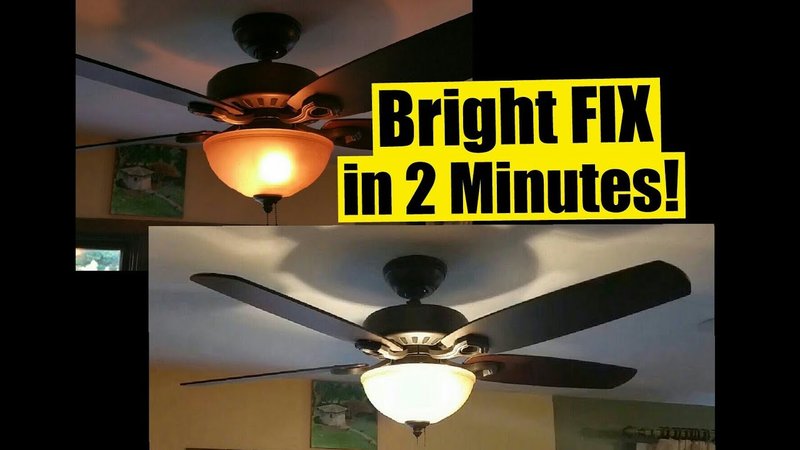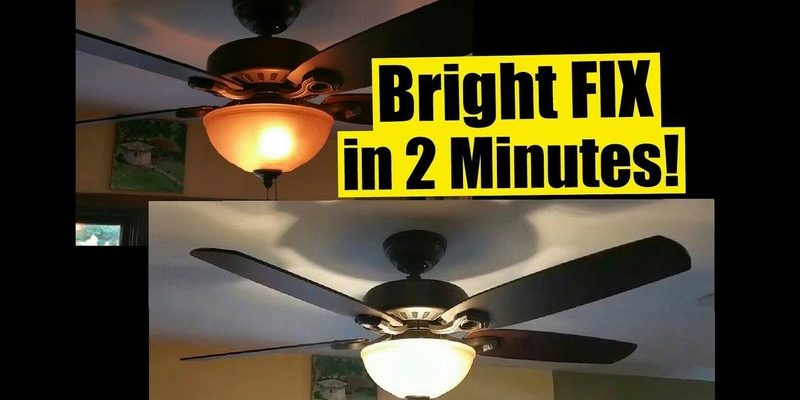
Honestly, fixing flickering lights can seem tricky if you’re not into gadgets or home tech. But here’s the thing: with many Lutron ceiling fan remotes, the solution can be surprisingly simple. This remote is designed for user-friendly control—think of it like your TV clicker but for your ceiling fan and lights—and it gives you a handful of ways to troubleshoot those annoying blinks. Let me walk you through what’s going on, why it happens, and—most importantly—how you stop it.
Common Causes of Flickering Lights With Ceiling Fan Remotes
Before you start pressing buttons or climbing ladders, it helps to know why your lights are flickering with a Lutron remote. There are a few main culprits, and most are fixable with some patience and the right steps.
- Loose bulbs or sockets. Sometimes it’s not the remote at all. If the bulb isn’t screwed in tight, or the socket is slightly off, you’ll get an unreliable connection. The electricity cuts in and out, causing that pulse or flicker.
- Bad connections or wiring. Over time, wiring can loosen or corrode, especially in older homes. The ceiling fan itself, the wall switch, or even the remote’s receiver in the fan can be to blame.
- Bulb compatibility. Lutron remotes are usually compatible with standard bulbs, but some LED or smart bulbs don’t play nicely with dimming or remote circuits. If you’ve recently changed bulbs, this could be the entire issue.
- Remote sync or code issues. If the remote and the receiver aren’t communicating clearly, you might see the fan working but the lights acting odd. Sometimes this is a quick fix—like re-pairing or resetting the remote codes.
Here’s an example: My neighbor swapped out all the bulbs in her living room fan for fancy color-changing LEDs, but didn’t realize her Lutron remote wasn’t compatible. The result? Flicker central. We swapped back to regular dimmable LEDs, hit the reset, and voilà—problem solved.
How Lutron Ceiling Fan Remotes Control Your Lights
Understanding how your Lutron remote works helps demystify the troubleshooting process. This isn’t “just” a universal remote; it’s designed to communicate wirelessly with a receiver tucked inside the ceiling fan assembly. When you press a button, it sends a signal—basically a tiny code—to tell the fan or lights what to do.
So when you dim the lights, for instance, the remote is actually adjusting the amount of voltage going to your bulbs. That’s why bulb compatibility matters so much; not all bulbs handle the voltage shifting equally well. Some cheap LEDs or off-brand bulbs will flicker if they get less than full power, especially at lower brightness settings.
With a Lutron ceiling fan remote, every function—fan speed, light brightness, on/off—relies on a stable connection between the handheld (or wall-mounted) remote and the receiver. If that gets interrupted by interference, battery problems, or a pairing issue, you might see flickering or unresponsive lights. Knowing this can save you hours of frustration chasing the wrong problem.
Step-by-Step: How To Fix Flickering Lights Using Lutron Ceiling Fan Remote
Here’s where things get practical. You don’t need to be an electrician (or even super handy) to try these steps. If you can safely reach your fan, you can probably fix most flickering issues in under 20 minutes.
1. Check & Tighten Your Bulbs
This sounds basic, but loose bulbs are the
2. Confirm Bulb Compatibility
Not all LED bulbs are dimmable or compatible with Lutron remotes. Look for bulbs labeled “dimmable” and check the wattage. Non-dimmable or ultra-low-cost bulbs often cause rapid flickering. If in doubt, try a standard incandescent bulb as a test.
3. Replace Remote Batteries
You might be wondering: Can batteries really cause flickering? Yes! If your remote’s batteries are dying, signals can get weak or cut out. Pop in fresh batteries and test the lights again.
4. Pair or Reset the Remote
If pressing buttons does nothing, or you’ve just swapped batteries, the remote may need to be re-paired with the fan receiver. Most Lutron remotes use a “pair” button—sometimes under the battery cover—so check your manual. Hold this for several seconds, wait for a confirmation blink or beep, and try the lights again.
5. Power Cycle the Fan
Turn power off at the wall switch or breaker for about a minute, then turn it back on. This resets the receiver and can clear minor sync issues.
Take your time on each step. Rushing through can miss something simple—like a dead battery or a single loose wire causing all the drama.
If you work through these and still see flickering, the culprit might be deeper wiring issues or a defective receiver. At that point, reaching out to an electrician isn’t admitting defeat—it’s just being safe.
How To Reset or Re-Sync Your Lutron Ceiling Fan Remote
Resetting and pairing are like “turning it off and on again” for your remote and fan connection. Sometimes, an electrical surge, drained battery, or even nearby wireless devices can cause the remote and receiver to lose sync.
- Resetting the remote: Usually, you’ll press and hold a specific button (often labeled “Learn” or “Pair”) for several seconds. Watch for the indicator light to blink.
- Syncing the fan and remote: With the receiver powered on, press the pairing button on the remote. You might need to stand close to the fan during this step. If you hear a faint click, see the light flash, or the fan spin, you’re paired!
- Testing the setup: Try turning the lights on and off, and adjust the brightness. If everything responds smoothly, you’ve fixed the flicker.
Let me explain: Think of this like re-introducing two friends who lost touch at a party (your fan and your remote). Once they “shake hands” again, things tend to work a lot better.
Troubleshooting Bulb and Dimmer Compatibility
Compatibility is a sneaky troublemaker. Lutron remotes are made for dimmable fixtures, but that won’t matter if your bulbs refuse to cooperate. LED technology, especially, has quirks.
- Dimmable LEDs vs standard LEDs: Always use bulbs marked as “dimmable.” Standard LEDs often flicker or buzz on remote circuits, even at full brightness.
- Wattage and minimum load: Old-school dimmers sometimes need a minimum wattage to work right—if you’re using just one low-watt bulb, the circuit might not be happy. Pair with higher-wattage or multiple bulbs if you suspect this is your problem.
- Try different bulb brands: Not all LEDs are created equal. Some cheap or no-name brands don’t run smoothly on Lutron receivers. If in doubt, test with another reputable brand.
Honestly, I’ve seen folks pull their hair out, thinking the remote is broken, only to find out it’s a $2 bulb causing the trouble. When in doubt, swap bulbs and see if the issue disappears.
When To Replace the Lutron Receiver or Remote
Not all flickering comes from user error or bad bulbs. Sometimes, hardware does fail. Lutron remotes and receivers are sturdy, but years of use, power surges, or physical damage can create problems inside the units themselves.
You might be wondering how to spot a bad receiver or remote. Some tell-tale signs:
- Remote won’t pair, even after fresh batteries and resets.
- Receiver clicks but nothing happens, or flickering gets worse when you adjust brightness.
- Other fan or light functions stop working too (not just flickering).
If you’ve worked through the earlier steps and nothing solves the problem, replacing the receiver (the little box inside the fan canopy) or getting a new Lutron remote is often the simplest fix. Compared to wrestling with old wiring, swapping out a remote is a breeze.
If you’re not comfortable with ceiling fan wiring, no shame in calling a pro. Electricity always deserves a little caution and respect.
Comparing Lutron Ceiling Fan Remote to Other Solutions
You might be tempted to try a universal ceiling fan remote. Here’s where Lutron stands out: it’s designed for smoother dimming and fewer compatibility headaches with major lighting brands. Many generic remotes offer basic on/off but don’t handle dimming or multi-speed fans as gracefully.
- Lutron remote: Integrated dimming, clear pairing process, reliable performance. But sometimes picky with bulb compatibility.
- Universal remote: Great if you’ve lost your original remote, but often struggles with fancy dimming or multiple fan speeds. Might not pair easily with Lutron receivers or advanced “scene” features.
- Wall switch controls: Reliable, but you lose the convenience of controlling the fan and light from across the room (or bed).
If you already have a Lutron setup, it’s almost always easier—and more reliable—to troubleshoot the existing system rather than start over with a universal. Plus, you keep the features that make Lutron fan remotes so convenient in the first place.
Final Checks and When to Call an Expert
So, you’ve tightened bulbs, swapped to dimmable LEDs, changed the batteries, and played matchmaker between your remote and fan. Most flickering issues should be history by now. But if you’re still getting disco vibes and nothing else works, it might be time for more advanced troubleshooting.
Here’s what you can double-check:
- Inspect the wiring in your fan’s canopy. Look for any loose, frayed, or burnt wires. If you spot something off, this is the job for a licensed electrician.
- Test with another known-good remote (if available). This can confirm if the issue is with your original remote or the receiver itself.
- Consider electrical interference. Rare, but microwave ovens, WiFi routers, or even cordless phones nearby can sometimes mess with wireless signals.
If nothing resolves it, don’t stress. Sometimes, home wiring is genuinely complicated—especially in older houses—and the safest route is letting a pro look things over. Safety always wins over stubbornness.
You deserve a space that feels comfortable, calm, and—yes—well lit. Don’t settle for less just because a remote or bulb is being stubborn.
After a little troubleshooting, most Lutron ceiling fan remote issues are fixable right at home. With a bit of patience and these simple steps, your lights will be back to steady and reliable—leaving the flickers and flashes for the movies, where they belong.
